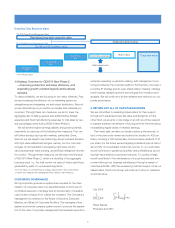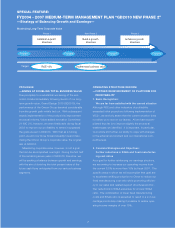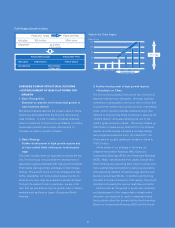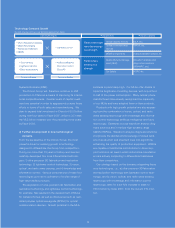Omron 2004 Annual Report Download - page 17
Download and view the complete annual report
Please find page 17 of the 2004 Omron annual report below. You can navigate through the pages in the report by either clicking on the pages listed below, or by using the keyword search tool below to find specific information within the annual report.
15
integrated (LSI) chips are limited to the integration of
electronic circuits, but the realization of three-dimension-
al structures has enabled the extreme miniaturization of
various sensing functions and actuators, which can be
applied in a wide variety of fields.
OPERATING RESULTS IN FISCAL 2003
Although the business climate surrounding
the ECB segment has been positively
impacted by steadily rising demand for
consumer appliances, telecommunications
infrastructure, and the mobile device indus-
try, profitability has been pressured by fac-
tors such as the strong yen and the price
erosion by competition and customers’
requests.
Domestic sales for the fiscal year under
review were up 10.2% compared to the
previous fiscal year, to ¥47.5 billion, while
overseas sales were up 14.3%, to ¥41.5
billion, for a total increase of 12.1% to
¥89.0 billion. Despite the trends toward a
stronger yen and price erosion, however,
growth led by technology designed to set
us apart from competitors succeeded in
boosting operating profits by 41.6%.
Reviewing products, high value-added
products for cellular phones showed espe-
cially strong growth, with the backlights
released in fiscal 2001 expanding to reach
sales of ¥7.5 billion, or double the figure for
the previous year. Narrow pitch flexible
printed circuit (FPC) connectors and LED
light modules for cellular phones, produced
using ultra-precision 3D fabrication and
replication technology, also showed con-
sistent sales growth. In addition, sales of
signal relays for base station grew substan-
tially due to rapid expansion in the
telecommunications infrastructures in
China and Europe.
FUTURE OUTLOOK AND STRATEGY
For fiscal 2004, we expect that severe
price competition will continue although
the demand for digital consumer appli-
ances and cellular telephony is still on the
rise. The Omron Group will accordingly
move to develop new growth areas, and
will focus on the combination of ultra-pre-
cision 3D fabrication and replication and
lightwave control technologies for applica-
tion in optical display devices, optical
communications devices, and MEMS. In
the area of optical display devices, in par-
ticular, we are actively pursuing large-
scale backlights used in televisions and
monitors. With this end in view, we
acquired the backlight business of KOA
Corporation in June 2004. Due primarily to
the expansion in the new growth area, we
expect the segment’s sales to achieve
20.2% year-on-year growth in fiscal 2004,
to
¥
107.0 billion.
This sensor is able to measure
gas velocity and direction at
extremely low flow rates, using
newly developed MEMS
device. With this sensor, it is
possible to detect even such
slight movements as butterfly’s
flutter.
This DC power relay allows
quickly-interrupting high voltage
current loads safely and silently,
thus contributes to the diffusion
of clean energy vehicles such
as hybrid cars and fuel cell
vehicles.
DC Power RelayMEMS Flow Sensor
























